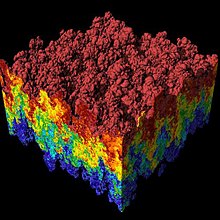Morse/Long-range potential
| Computational physics |
|---|
 |
The Morse/Long-range potential (MLR potential) is an
- the c-state of dilithium (Li2): where the MLR potential was successfully able to bridge a gap of more than 5000 cm−1 in experimental data.[2] Two years later it was found that the MLR potential was able to successfully predict the energies in the middle of this gap, correctly within about 1 cm−1.[3] The accuracy of these predictions was much better than the most sophisticated ab initio techniques at the time.[4]
- the A-state of Li2: where Le Roy et al.[1] constructed an MLR potential which determined the C3 value for atomic lithium to a higher-precision than any previously measured atomic oscillator strength, by an order of magnitude.[5] This lithium oscillator strength is related to the radiative lifetime of atomic lithium and is used as a benchmark for atomic clocks and measurements of fundamental constants.
- the a-state of KLi: where the MLR was used to build an analytic global potential successfully despite there only being a small amount of levels observed near the top of the potential.[6]
Historical origins
The MLR potential is based on the classic
Function
The Morse/Long-range potential energy function is of the form
This long-range form of the MLR model is guaranteed because the argument of the exponent is defined to have long-range behavior:
There are a few ways in which this long-range behavior can be achieved, the most common is to make a polynomial that is constrained to become at long-range:
It is clear to see that:
Applications
The MLR potential has successfully summarized all experimental spectroscopic data (and/or virial data) for a number of diatomic molecules, including: N2,[7] Ca2,[8] KLi,[6] MgH,[9][10][11] several electronic states of Li2,[1][2][15][3][10] Cs2,[16][12] Sr2,[17] ArXe,[10][18] LiCa,[19] LiNa,[20] Br2,[21] Mg2,[22] HF,[13][14] HCl,[13][14] HBr,[13][14] HI,[13][14] MgD,[9] Be2,[23] BeH,[24] and NaH.[25] More sophisticated versions are used for polyatomic molecules.
It has also become customary to fit ab initio points to the MLR potential, to achieve a fully analytic ab initio potential and to take advantage of the MLR's ability to incorporate the correct theoretically known short- and long-range behavior into the potential (the latter usually being of higher accuracy than the molecular ab initio points themselves because it is based on atomic ab initio calculations rather than molecular ones, and because features like spin-orbit coupling which are difficult to incorporate into molecular ab initio calculations can more easily be treated in the long-range). MLR has been used to represent ab initio points for KLi[26] and KBe.[27]
See also
References
- ^ PMID 19947682.
- ^ S2CID 119266866.
- ^ S2CID 119263860.
- .
- .
- ^ PMID 17523810.
- ^ PMID 17092076.
- ^ S2CID 94174485.
- ^ PMID 24093511.
- ^ S2CID 97119318.
- ^ PMID 18020428.
- ^ PMID 20210387.
- ^ .
- ^ .
- S2CID 119268157.
- PMID 21766938.
- S2CID 119243162.
- .
- PMID 22070298.
- .
- .
- PMID 23485290.
- PMID 24527923.
- S2CID 118542048.
- PMID 25637985.
- .
- PMID 23968090.













